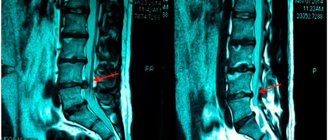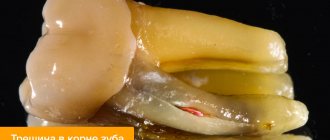Why do ulcers appear on the gums, and is it always dangerous?
There are many possible reasons. To understand how dangerous the appearance of certain lesions on the gums is, you need to look at additional accompanying symptoms:
- in case it is trivial mechanical damage. The gums can be damaged by hard food, a toothbrush, or a foreign object. These lesions may resolve in 3-5 days. If a person does not brush his teeth, then infection is added to these damages, and healing may take several weeks.
- Sometimes ulcers can appear as a result of wearing orthodontic structures, braces or removable dentures.
Causes of cracked teeth
The force of pressure on the teeth when chewing reaches 400 kg/cm². Healthy and strong crowns can easily cope with such a load. If the enamel is weakened or excessive pressure is applied, the tooth can crack. Factors contributing to the appearance of cracks in teeth:
- malocclusion, bruxism;
- depulpation (removal of a nerve);
- absence of one/several teeth (uneven load distribution);
- deep caries (destruction of 50% of the crown or more);
- injuries (fall, blow to the face, accident);
- genetically determined weakness of tooth enamel;
- poor nutrition leading to a lack of fluoride, calcium, phosphorus;
- excess sugar in the diet;
- temperature changes when eating (cold-hot);
- habit of biting pens and nails;
- teeth whitening at home;
- traumatic treatment of dental canals, excessive tightening of braces.
Important! Teeth with weakened enamel may crack when eating hard foods (such as crackers). However, chipped teeth more often occur due to prolonged exposure to adverse factors.
The most common diseases of the oral cavity in which ulcers appear
- ulcerative necrotizing gingivitis. The cause of this disease is bacteria that multiply when immunity decreases. Extensive ulcers appear on the gums, regional lymph nodes become enlarged, and the temperature may rise
- chronic recurrent aphthous stomatitis. Up to 4-5 white spots first appear in the mouth, which later turn into ulcers. There is no temperature or other problems related to well-being. If such symptoms appear 1-2 times a year in small quantities, then there should be no cause for concern. Frequent occurrence is associated with weakened immunity and possible intestinal diseases, as well as allergies.
- acute herpetic stomatitis. Herpetic stomatitis occurs in a child when he first encounters the herpes virus. Many bubbles appear on the gums, which, after bursting, turn into ulcers that merge with each other. The gums are always bright red, and the ulcers themselves are very painful, the temperature may rise
How to tell if a tooth is cracked
When a tooth cracks, patients notice a click. However, it is not always possible to see a crack with the naked eye, and pain often appears later. If a tooth is cracked and puts pressure on the gum, soft tissue swelling occurs and inflammation develops.
Bacteria enter the pulp through destroyed enamel. Patients note increased sensitivity to hot/cold foods and complain of pain when closing their jaws. Bad breath appears in the absence of caries. When chewing, the crack enlarges and, without treatment, leads to a tooth fracture or provokes severe pain due to nerve damage.
Important! A brown or black crack on a tooth indicates that food debris and bacteria have entered deep into the crown. Even damage to the enamel that is not noticeable at first leads to the development of caries.
First aid
If the temperature rises, you can take an antipyretic drug. In the future, before visiting a doctor, nothing should be done. Do not take antibiotics yourself or try to get into the ulcer with any object.
How to relieve symptoms of ulcers
- do not eat sour and salty foods
- food should be warm, no hot dishes or drinks
- Care should be taken to ensure that the child does not put dirty hands in his mouth
- teeth should be brushed, but make sure that the bristles do not touch the gums with ulcers
- It is recommended to rinse your mouth with herbal solutions (oak bark, chamomile) 3-4 times a day
You should be careful when using antibacterial solutions. They must be prescribed by a doctor. If such solutions are used incorrectly, they can provoke the development of thrush. The antibacterial agent will “kill” the beneficial microflora, which can result in a fungal infection.
Prevention of ulcers
- professional oral hygiene at least 2 times a year
- Regularly replacing your toothbrush
- Proper brushing of teeth at least 2 times a day
- using additional hygiene techniques such as irrigators, dental floss, and tongue scrapers
- Children should be monitored for bad habits such as putting dirty fingers and other objects into their mouths
- It is important to treat your teeth in a timely manner. Microbes that are found in carious teeth and rotten roots can serve as a source of infection for ulcers
If you have problems in the oral cavity, contact the specialists of the Center for Family Dentistry!
SOS remedies against bleeding gums
Sometimes it’s impossible to get to the doctor and you need to wait 1-2 days until the appointment. In this case, several SOS tools will help.
- Rinses: chlorhexidine, oak bark decoction, LACALUT Aktiv rinses with aluminum lactate and sodium fluoride, PRESIDENT Antibacterial with plant extracts - relieve inflammation, prevent bleeding.
- Gels: Cholisal, Parodontocid - reduce pain, remove signs of inflammation.
- Pastes: Forest balm - contains oak bark, stops bleeding, strengthens gums.
All means must be used comprehensively. First, brush your teeth, then rinse (1 minute). After this, the solution is spat out and the gums are dried with gauze: this way the gel is better fixed. Then use ointments, applying with your finger to the entire inflamed surface. If saliva comes out during treatment, you should not swallow it, you need to spit it out.
After the procedure, you should refrain from drinking for 30 minutes and from eating for 2 hours. Treatment is carried out twice a day: after breakfast and at night.
The most effective remedy for diseases in which the gums begin to bleed is antibiotics. They help to quickly relieve inflammation and improve well-being. But they are available with a prescription and are taken only as prescribed by a doctor. Therefore, you won’t be able to buy and prescribe antibiotics yourself. It is better to immediately make an appointment with a specialist so as not to waste time and money on something that will not solve the problem, but will only delay the inevitable.
Restoring tooth enamel
- To restore enamel on a cracked tooth, the enamel is remineralized, coated with a fluoride-containing compound, and a protective coating is applied on top of it. It hardens when exposed to light rays.
- Filling is used for deep damage: chips or trauma to the tooth root.
- Covering with veneers covers a damaged tooth.
- Tooth extension. In case of some damage, for example, if a piece of a tooth breaks off, it can be built up and the previous shape of the tooth restored.
To eliminate the problem of a cracked tooth, you need to contact a dentist as soon as possible, who will determine the type of crack and suggest a way to eliminate it.
ROOT CANAL TREATMENT
Some cracks affect not only the surface, but also the inner layers of the tooth. If the crack is deep enough to reach the pulp underneath the enamel and dentin layers, a root canal may be necessary to treat the inflamed pulp and save the tooth. If a root canal is performed to treat a cracked tooth, the dentist will then place a crown on the treated tooth. Although the name of the procedure may sound intimidating, the American Association of Endodontists (AAE) says that the procedure itself is similar to a simple dental filling and is relatively convenient in modern conditions.
EXTENSION
There are several ways your dentist can repair a cracked front tooth. A build-up, for example, usually involves applying a composite resin that is a color similar to your real teeth to fill the crack. Compared to other methods of treating a cracked tooth, bonding is one of the least expensive and requires fewer visits to the dentist. Although dental veneers can restore a tooth in just one appointment, the material used is not as durable as others. Because of its fragility, the material - according to the Cleveland Clinic. – more suitable for teeth that do not experience much chewing pressure, such as the front teeth.
Fistula on the gum: what to do?
The most important thing that a person who has pain in the gums should understand is that they need to see a doctor as soon as possible, and not wait for the symptoms to disappear and not use various gels and other means. Yes, they can bring relief, but it will be a temporary relief of symptoms, not healing.
There are several treatment options for fistula.
Endodontic method for treating gum fistula
The method is applicable if the following conditions are met:
- the dental canal and its branches are visible;
- it is clearly visible in the tooth canal whether there are cracks or not.
Treatment is carried out under a microscope. The apical part is sealed with modern high-quality materials that are biocompatible with natural tissues. Canal therapy is performed, which allows the fistula to be eliminated.
Mixed treatment
If the lesion is quite severe, the therapist will need the help of a surgeon.
The therapist cleans the canals and seals the apical part of the root. The surgeon's job is to polish this area of the root. Polishing is carried out using ultrasonic nozzles, which allows you to achieve an ideal result.
Surgery
If the inflammatory process has gone too far, the tooth will have to be removed. The source of inflammation is eliminated along with the tooth and root.
In the future, an implant can be installed in this place at the request of the patient: this is a rather expensive procedure, so it is not recommended to delay the treatment of the fistula. The earlier the patient consults a doctor, the easier and cheaper it will be to cure the disease.
Autotransplantation
This is a type of surgical treatment. In this case, the implant is another tooth of the patient (as a rule, it is a wisdom tooth, which is a kind of reserve, since it is not involved in chewing food).
The advantage of the method is that the person’s own tooth is transplanted, which negates the risk of tissue rejection.
Development of a fistula on the gum
The process of fistula formation takes a fairly long period of time: for this to happen, inflammatory processes must occur in the tissues of the damaged tooth.
The stages that a tooth usually goes through before a fistula appears are as follows:
- caries is formed;
- the disease goes into a deep form;
- the development of caries leads to the formation of pulpitis;
- the last stage is periodontitis.
If you ignore periodontitis and do not take measures to treat it, the disease becomes chronic. At the moment of exacerbation, purulent masses come out through the fistulous tract formed in the gum.
The appearance of a fistula due to unsatisfactory canal filling
Canal filling is a fairly common dental procedure indicated in the treatment of diseases such as periodontitis, pulpitis and in preparing teeth for subsequent prosthetics. However, in more than half of the cases, the canals are not filled as well as required by the rules. The most common mistake is filling not to the very top of the root.
Due to a mistake made by the doctor, an infection will form in the unsealed area of the canal over time, which sooner or later will go beyond the boundaries of the tooth and lead to inflammation. In addition to filling the entire length of the canal, the substance used to fill the canal during the procedure must be packed tightly: the appearance of voids and the formation of pores is unacceptable.
The main symptom indicating problems with the tooth is pain when biting. If you look carefully, in the immediate vicinity of the diseased tooth you can easily find a small hole through which pus will come out.
The appearance of a fistula on the gum, the treatment of which is not recommended to be delayed, indicates that the tooth will not stop hurting on its own. To treat it, the tooth is unfilled, an anti-inflammatory medicine is placed in the canals, which is removed after a certain period of time, and the canals are then filled again.
If a tooth has a crown or a pin, unfilling the canals becomes a real problem for the doctor. It is not always possible to remove the pin, and the crown will have to be re-installed after the procedure is completed, which is fraught with additional financial costs for the patient. Sometimes, if the canal is not sealed at its very end, the doctor decides to resort to a procedure for resection of the upper part of the root.
Resection is far from the most difficult operation: its duration is no more than an hour. The operation consists of several main stages:
- Preparation, during which the canals are carefully sealed a couple of days before the main procedure.
- Anesthesia. The operation is performed under local anesthesia: the patient does not feel pain during the doctor’s manipulations, but discomfort may occur later when the effect of the injection wears off.
- Gaining free access to the upper region of the root. To do this, the dentist cuts the gum, exposing the bone tissue, in which a hole is then cut using a drill.
- Through the resulting hole, the doctor cuts off the tip of the root, to which, as a rule, the cyst is attached, which causes inflammation.
- After removing part of the root, an empty cavity remains in the bone. The doctor can fill the space with synthetic tissue, which speeds up the growth process of natural bone.
- The final stage is suturing the gums. For intensive outflow of ichor, drainage can be installed for several days.
Treatment options
Depending on the type of crack, it can be masked. This applies to diagonal cracks, which I mask with veneers. A horizontal crack can be repaired. To do this, the damaged part of the tooth is removed and the remaining part is filled. In this case, a crown can be placed on the tooth.
In case of a vertical crack, the pulp is drilled out and the tooth is filled with further prosthetics.
Main symptoms of fistula
Before the formation of a fistula, the tooth begins to hurt: when pressing on it and the surrounding area, painful sensations arise, it seems that the tooth is bursting from the inside.
Body temperature may rise and the gums may swell. When the pus comes out, the patient feels relief, thinking that the attack is over. However, this is a misconception: the disease continues to develop, although at this time the person feels much better. The tooth stops hurting, and pus no longer forms.
If no action is taken, the damage will affect the bone tissue, which will require more complex and lengthy treatment.











